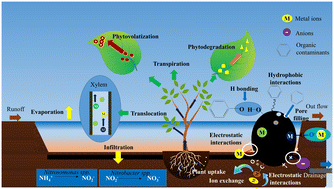Biofilters and bioretention systems: the role of biochar in the blue-green city concept for stormwater management†
Abstract
The main aim of the blue-green city concept is the reduction of the adverse impacts of stormwater by recreating the natural water cycle with the aid of green infrastructure in major metropolitan areas worldwide. The key types of blue-green infrastructures (BGIs) are constructed wetlands, water retention basins, green roofs, and permeable pavements. Bioretention systems are made of plants and a layer of mulch, and soil where both plants and soil medium reduce the runoff volume and contaminant concentration in the stormwater. Recently, biochar has been applied to bioretention systems due to its porous structure, which facilitates the adsorption of inorganic and organic pollutants. However, most of these were laboratory studies with synthetic or semi-synthetic stormwater and thus had little ecological parallel and resemblance with real-life (field) situations. Therefore, we critically discuss the use of biochar and modified biochar-incorporated bioretention systems constructed in both laboratories and pilot scales in metropolitan areas and the efficiency improvement of the BGIs. Most reviews in the existing literature mainly focused on the BGI types, major components in bioretention systems, and their functionality in stormwater management. However, a systematic analysis of biochar and modified biochar incorporated bioretention systems in both laboratories and pilot scales is scarce. Biochar-incorporated bioretention systems significantly reduced the effluent volume and contaminant concentration in stormwater. Additionally, biochar supports the growth of plants in the bioretention system and adds aesthetic value to the surrounding area. However, the efficiency of the bioretention system varies with several factors, such as the composition of the filter medium, properties of stormwater, plant types, and different environmental aspects. Hence, additional field-based research is required to estimate the benefits of biochar in the bioretention systems' efficiency.



 Please wait while we load your content...
Please wait while we load your content...